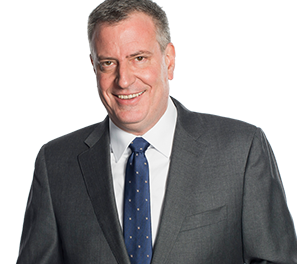NEW YORK CITY (TIP): Mayor Bill de Blasio on Wednesday, April 22, unveiled an ambitious revision to PlaNYC, the sweeping sustainability and resiliency blueprint for New York City first introduced by the Bloomberg administration. Rebranded as OneNYC, de Blasio’s update combines his vision for a more equitable city with the goal of dramatically reducing carbon emissions and mitigating waste.
“Addressing our environmental challenges is part of how we do address our economic challenges. The process of addressing the sustainability needs of our city is how we also battle inequality,” de Blasio said at a press conference in the Hunts Point neighborhood in the Bronx. “And this plan, for the first time in New York City, makes very clear that we’re going to fight income inequality in a very specific and tangible way.”
But while environmental advocates lauded the mayor’s vision, its sheer scope left some anxious for additional details on how it would be funded and implemented.
“We applaud the mayor for laying out an aspirational vision of the city we want to become,” said Marcia Bystryn, president of the New York League of Conservation Voters, in a press release. “As PlaNYC showed us, however, successfully achieving our ambitious goals requires a roadmap that allows us to measure progress.”
De Blasio’s goals are indeed ambitious: lifting 800,000 New Yorkers out of poverty by 2025, eliminating all landfill-bound waste by 2030, and reducing the city’s carbon emissions 80 percent below 2005 levels by 2050. In all, over 200 new initiatives are included in the new plan.
But the administration promises to deliver on the finer points as well.
“OneNYC and previous PlaNYCs have always been about overarching goals and initiatives-including the specific metrics that get us there-to create a comprehensive blueprint for the city’s future,” said de Blasio spokesperson Amy Spitalnick. “As the prior administration did, we’ll be rolling out further details on individual plans over the coming months.”
According to Spitalnick, the plan includes “over 80 specific new metrics and indicators-that will be publicly tracked and reported on annually (online for the public to review).”
Others point out that OneNYC’s success will depend in part on outside cooperation. Many improvements to bus, subway and rail service, for example, would fall under the jurisdiction of the Metropolitan Transportation Authority, a state-run agency that is by its own estimate facing a $15 billion capital deficit.
“There’s a lot here that the city can’t do on its own,” said Kate Sinding, a policy analyst at the Natural Resources Defense Council.
“Another critical component of this is … how the city approaches partners it’s going to need-first and foremost, the state.”
The administration did not address a request for comment on potential collaborations with the state.
The total cost of the plan and funding details are yet to be announced. The mayor’s executive budget is due to be released early next month.
